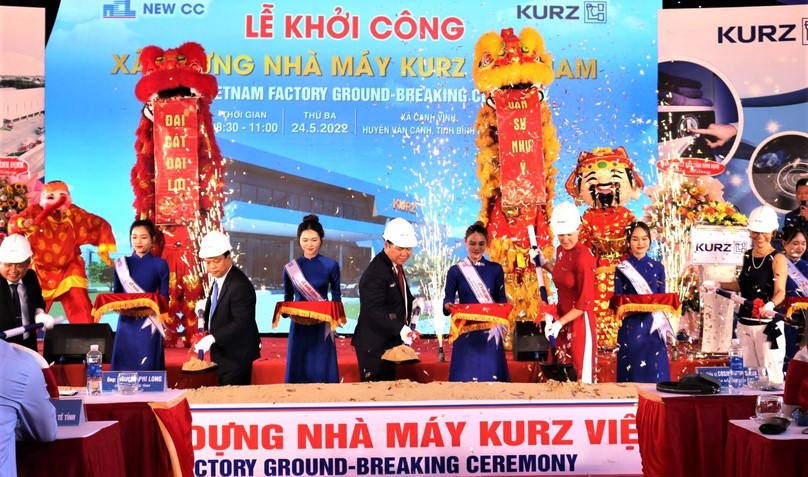The man who brings German investors to Binh Dinh province
Nguyen Huu Le, chairman of TMA Solutions, a Vietnamese software outsourcing partner for international companies, is known as a businessman connecting German companies with the coastal central province of Binh Dinh. Le talks with The Investor about the investment opportunities arising from Binh Dinh, his hometown.
Marko Walde, chief representative of the German Industry and Commerce Vietnam (AHK Vietnam), expressed his thanks to you at a recent German investment promotion conference in Binh Dinh. Why is that?
It’s a blessing. I have my company office at Quang Trung Software City in Ho Chi Minh City. Over there, I know a German CEO who introduced Marko to me.
Since then, I’ve had opportunities to approach Marko, inviting him to visit my home province of Binh Dinh. It’s advisable that FDI inflows should expand outside HCMC and nearby provinces like Dong Nai and Binh Duong. German companies do not hesitate to set up factories in places far from big municipalities because they care about the environment. Knowing this, I said to Marko that to help German companies, he should give central Vietnam a try, and why not my Binh Dinh province.
When arriving in Binh Dinh, he liked it very much. At that time, I was building my TMA Innovation Park in Binh Dinh, so Marko trusted me even more. He made up his mind and has repeatedly brought German companies and business delegations to Binh Dinh. Most visitors feel very satisfied with the province’s business environment as well as incentives it offers.
For Quy Nhon Port, Marko sees it as a good and well-operated facility. As for Quy Nhon University, he said the institution has strengths in information technology, maths, engineering, and so on.
Also through Marko, I had the opportunity to approach Kurz Group, a major German company in hot-stamping and thin film technology. In December 2020, Marko told me to go to the office to meet with Kurz representatives. They were selecting either Quang Nam or Binh Dinh to build a plant. I recommended Binh Dinh and volunteered to be an assistant to Nguyen Phi Long, then chairman of Binh Dinh Provincial People’s Committee. I served as an interpreter and go-between for the parties involved. After that, Kurz Group decided to build their plant at VSIP Binh Dinh Industrial Park in Nhon Hoi Economic Zone, Van Canh district.

Kurz breaks ground for its coatings plant on May 24, 2022 in Binh Dinh province, central Vietnam. Photo courtesy of the province's portal.
Later, when PNE AG started to show an interest in an offshore wind farm project in Vietnam with an estimated investment of $4.6 billion, I also had the opportunity to meet their leaders, and recommended Binh Dinh.
PNE AG had many choices including Binh Dinh and southward to Binh Thuan or further to Soc Trang. But Binh Dinh has the advantage of being a gateway to the whole Central Highlands region, and PNE AG selected Binh Dinh. Other opportunities are industrial parks in the province.
Your hometown, Binh Dinh, is encouraging green projects to embrace sustainable development. What do you think about the trend?
It is very necessary. Green production will be a requirement when other countries import products from Vietnam. Some countries have brought carbon neutrality into their laws, like Germany. Therefore, Vietnam should pursue carbon neutrality as soon as possible. Germany is still the largest economy in Europe, and it pays special attention to environmental issues. German companies are interested in Vietnam.
Binh Dinh authorities have facilitated Kurz Group and PNE AG in their investment in the province. They have noticed.
Binh Dinh has some advantages compared to other provinces, even some northern provinces. This can serve as good conditions for international investors to come to central Vietnam, home to Binh Dinh.
You have also invested in Binh Dinh. What are your assessments of human resources in Binh Dinh and the entire central region?
The construction of my TMA Innovation Park started in the second quarter of 2019 and we opened it in the third quarter of 2020. Our 15.7-hectare facility is surrounded by a valley with a beautiful natural landscape, mountains and the sea, as well as streams and lakes. Such greenery and open space offer a fresh and ideal environment for innovations.
I selected Binh Dinh as it is my hometown. Besides, Binh Dinh also focuses on developing science and technology with the development of the Innovation Valley project, where world-leading scientists are working.
Binh Dinh is also a bright spot in luring FDI, offering a transparent investment environment and many business incentives. Provincial officials are supportive.
When I started my business here, I had 80 staff members and the total is 500 now. In HCMC, the need for software personnel is higher, so it is more difficult to recruit. In the central region, especially in Quy Nhon, the hub of Binh Dinh, it’s a little bit easier. In Quy Nhon now, just TMA and FPT are major software companies.
Our TMA is the top priority for Quy Nhon University graduates looking for a job. Here, human resources are more stable than in HCMC, where employees quit or change jobs much more frequently.
Among 500 employees working at TMA now, three quarters are from universities in the central region, with a majority from Quy Nhon University. In the future, I hope that ratio will be higher.
I think HCMC’s living conditions are becoming more difficult than here. To date, our TMA Innovation Park in Binh Dinh has become more popular as a new and fresh environment for creative work.
Generally speaking, higher educated students in the central region cannot compete with their peers in HCMC, especially in English skills. However, their ability to learn quickly allows them to catch up relatively fast.




